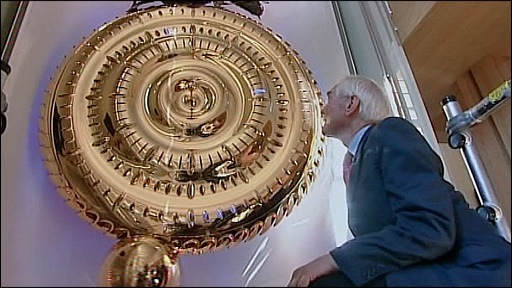Because, of course, you can’t spell πράγματος without π.

Pi Day is also Einstein’s birthday, so we’ll take as our text for today, “I want to know God’s thoughts; the rest are details.” I’ve been saving up a couple of links, so pay attention.
First, via Brad DeLong, Boltzmann’s Universe at Cosmic Variance.
Here’s how it goes. Forget that we are “typical” or any such thing. Take for granted that we are exactly who we are — in other words, that the macrostate of the universe is exactly what it appears to be, with all the stars and galaxies etc. By the “macrostate of the universe,” we mean everything we can observe about it, but not the precise position and momentum of every atom and photon. Now, you might be tempted to think that you reliably know something about the past history of our local universe — your first kiss, the French Revolution, the formation of the cosmic microwave background, etc. But you don’t really know those things — you reconstruct them from your records and memories right here and now, using some basic rules of thumb and your belief in certain laws of physics.
The point is that, within this hypothetical thermal equilibrium universe from which we are purportedly a fluctuation, there are many fluctuations that reach exactly this macrostate — one with a hundred billion galaxies, a Solar System just like ours, and a person just like you with exactly the memories you have. And in the hugely overwhelming majority of them, all of your memories and reconstructions of the past are false. In almost every fluctuation that creates universes like the ones we see, both the past and the future have a higher entropy than the present — downward fluctuations in entropy are unlikely, and the larger the fluctuation the more unlikely it is, so the vast majority of fluctuations to any particular low-entropy configuration never go lower than that.
Therefore, this hypothesis — that our universe, complete with all of our records and memories, is a thermal fluctuation around a thermal equilibrium state — makes a very strong prediction: that our past is nothing like what we reconstruct it to be, but rather that all of our memories and records are simply statistical flukes created by an unlikely conspiracy of random motions. In this view, the photograph you see before you used to be yellow and wrinkled, and before that was just a dispersed collection of dust, before miraculously forming itself out of the chaos.
Note that this scenario makes no assumptions about our typicality — it assumes, to the contrary, that we are exactly who we (presently) perceive ourselves to be, no more and no less. But in this scenario, we have absolutely no right to trust any of our memories or reconstructions of the past; they are all just a mirage. And the assumptions that we make to derive that conclusion are exactly the assumptions we really do make to do conventional statistical mechanics! Boltzmann taught us long ago that it’s possible for heat to flow from cold objects to hot ones, or for cream to spontaneously segregate itself away from a surrounding cup of coffee — it’s just very unlikely. But when we say “unlikely” we have in mind some measure on the space of possibilities. And it’s exactly that assumed measure that would lead us to conclude, in this crazy fluctuation-world, that all of our notions of the past are chimeric.
Our spoilsport author goes on, “Now, just like Boltzmann’s Brain, nobody believes this is true,” but, just for Pi Day, let’s suspend our disbelief until tomorrow.
Speaking of Sean Carroll, we also have Michael Bérubé’s review of his forthcoming From Eternity to Here: The Origin of the Universe and the Arrow of Time.
Time just isn’t what it used to be. And space has gotten to be a bit of a problem, as well. When I was a lad, physicists told me that they had these things pretty well figured out: they had discovered material evidence of the Big Bang, they had adjusted their conception of the age and evolution of the universe accordingly, and, having recalculated the universe’s rate of expansion (after Hubble’s disastrous miscalculations threw the field into disarray), they were working on the problem of trying to figure out whether the whole thing would keep expanding forever or would eventually slow down and snap back in a Big Crunch. The key, they said, lay in finding all the “missing mass” that would enable a Big Crunch to occur, because at the time it looked as if we only had two or three percent of the stuff it would take to bring it all back home. When I asked them why a Big Crunch, and a cyclical universe, should be preferable to a universe that just keeps going and going, they told me that the idea of a cyclical eternity was more pleasing and comfortable than the idea of a one-off event; and when I asked them what came before the Big Bang, they patted my head and told me that because the Big Bang initiated all space and time, there was no such thing as “before the Big Bang.”
But now they tell me that most of that account of the world is wrong. For one thing, the expansion of the universe seems to be accelerating, which puts a crimp in the plans of everyone who’d been counting on its eventual collapse; worse still, no one can explain why it is that the universe is different now than it was, say, 14 billion years ago, or why it will be different 14 billion years from now. For the simple and stupefying fact remains that the laws of physics are reversible; nothing in those laws prevents time from running backwards, and it’s entirely possible to have universes in which conscious entities remember the future and remark offhandedly to each other that you can’t get some eggs without breaking an omelet. And yet, our universe obeys those reversible laws of physics even though effects follow causes, old age follows youth, and systems move from states of low entropy to states of high entropy. How can this be? How might it be otherwise?
It’s above my pay grade, this much I know. But thanks in part to local fluctuations in my corner of the universe that allow me to read books before they are written (these are known technically as Borges-Boltzmann Waveforms, or more colloquially, “wrinkles in time”), I can reveal that Caltech physicist Sean Carroll will have addressed—if not quite “answered”—these questions in his new book, From Eternity to Here: The Origin of the Universe and the Arrow of Time. (Not to be confused with this superficially similar book, which has been published in parallel universe XGH0046, where Frank Viola gave up a promising baseball career in order to become a Christian writer.)
…
Good stuff. Go get your pie (you’ll need two slices), follow the link (not neglecting the comments thread), settle back, and enjoy the day.

 No country takes toilets quite so seriously as Japan.
No country takes toilets quite so seriously as Japan.






